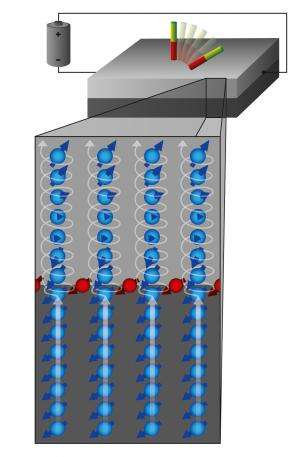Magnetic switching simplified

An international team of researchers has described a new physical effect that could be used to develop more efficient magnetic chips for information processing. The quantum mechanical effect makes it easier to produce spin-polarized currents necessary for the switching of magnetically stored information. The research findings were published online on 28 July in the high-impact journal Nature Nanotechnology.
Random-access memory is the short-term memory in computers. It buffers the programs and files currently in use in electronic form, in numerous tiny capacitors. As capacitors discharge over time, they have to be recharged regularly to ensure that no data are lost. This costs time and energy, and an unplanned power failure can result in data being lost for good.
Magnetic Random Access Memories (MRAMs), on the other hand, store information in tiny magnetic areas. This is a fast process that functions without a continuous power supply. In spite of this, MRAMs have yet to be implemented on a large scale, as their integration density is still too low, and they use too much energy, are difficult to produce, and cost too much.
One reason for this is that spin-polarized currents, or spin currents for short, are needed to switch the magnetic areas of the MRAMs. Spin is the intrinsic angular momentum of electrons that gives materials their magnetic properties, and it can point in two directions. Spin currents are electric currents that possess only one of these two spin types. Similar to the way in which the Earth's magnetic field affects the needle of a compass, a current of one of the spin types influences a magnetic layer and can cause it to flip.
To produce spin currents up to now, the desired spin type was filtered from normal electric current. This required special filter structures and high current densities. Thanks to the new effect identified by researchers from Jülich, Barcelona, Grenoble, and Zurich, magnetic information could now be switched more easily.
"We no longer need spin filters. Instead, we produce the spin current directly where it will be used. All that is needed is a layer stack made of cobalt and platinum," says Dr. Frank Freimuth from the Peter Grünberg Institute and the Institute for Advanced Simulation at Forschungszentrum Jülich. This reduces the amount of space required, makes the system more robust, and may simplify the production of magnetic chips.
An electric current, conducted through the stack at the interface, separates the spins in the platinum layer and transports only one spin type into the magnetic cobalt layer. This creates a torque in this layer that can reverse the magnetization. "Spin torques had already been observed in double layer systems in the past," says the physicist, who is part of the Young Investigators Group on Topical Nanoelectronics headed by Prof. Yuriy Mokrousov. "The fact that we have conclusively explained for the first time how they are created is a scientific breakthrough, because this will enable us to produce them selectively and investigate them in more detail."
The researchers identified two mechanisms that combine to produce the new effect, which they have dubbed 'spin-orbit torque': spin-orbit coupling and the exchange interaction. Spin-orbit coupling is a well-known relativistic quantum phenomenon and the reason why all electron spins of one type move from the platinum to the cobalt layer. Within the cobalt layer, the layer's magnetic orientation then interacts with the spins via the exchange interaction.
The researchers tested their theory successfully in experiments. Their next step is to calculate the effect in other materials with stronger spin-torque coupling to find out whether the effect is even more apparent in other material combinations.
More information: Symmetry and magnitude of spin-orbit torques in ferromagnetic heterostructures; K. Garello et al.; Nature Nanotechnology. Published online 28 July 2013; DOI:10.1038/NNANO.2013.145
Journal information: Nature Nanotechnology
Provided by Helmholtz Association of German Research Centres



















